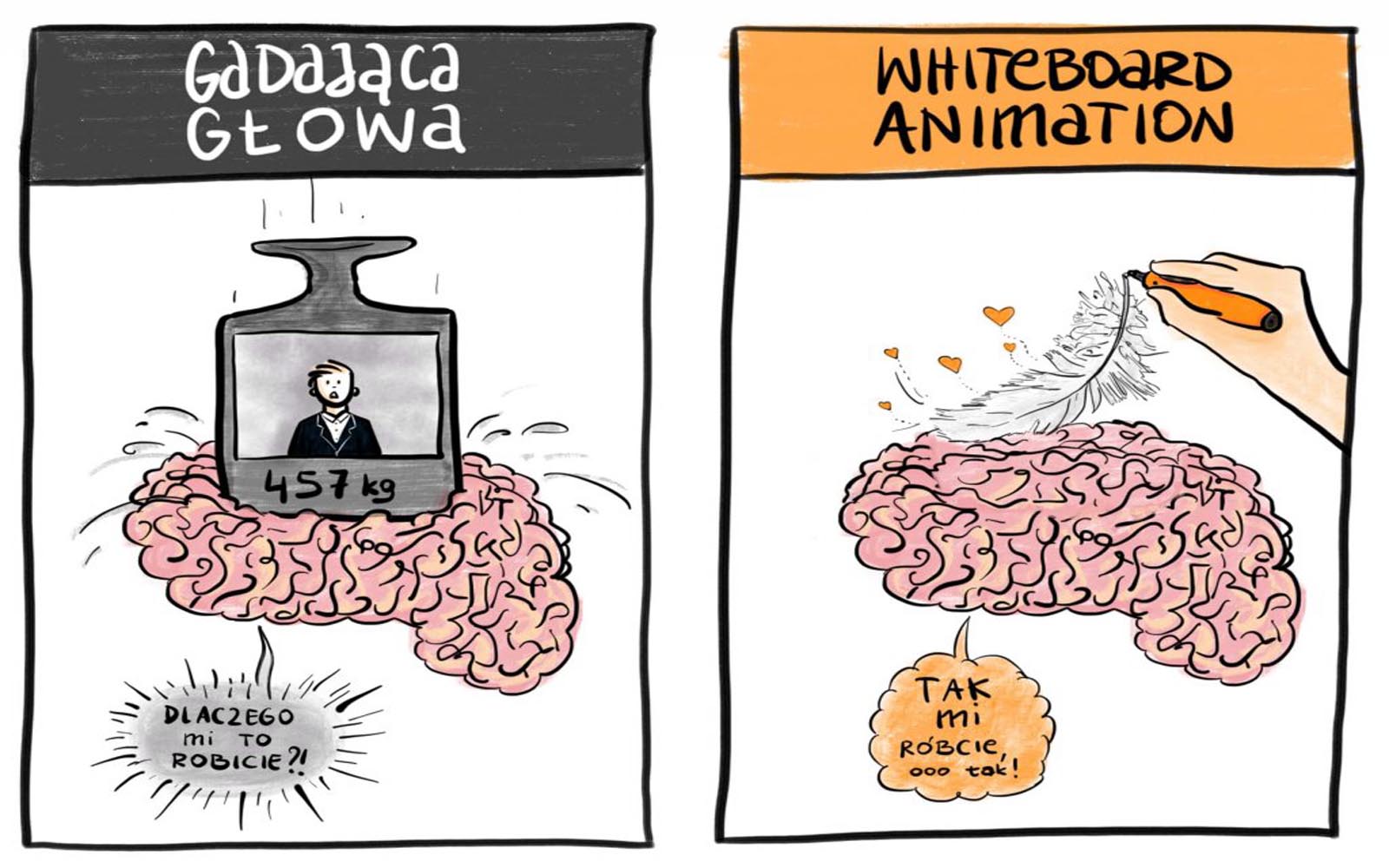It effectively presents the company’s offer and its strategy.
What does this result from?
For thousands of years drawings have facilitated interpersonal communication. We used to sit in a tribal circle, watching the leader draw a map of our territory in the sand. Today we look at the board, where a lecturer, trainer, or manager draws what is difficult to convey with words alone.

Despite the passage of time, drawing still helps us understand each other better. Especially today when the world around us is more complex than ever and there is less and less time for exhausting conversations.
The potential of drawing is used, among others, by whiteboard animation. Drawing animation of this kind helps explain complex matters in a transparent and engaging way. Whiteboards are widely used in business – they are used by companies such as Coca-Cola, Carlsberg, or Dropbox.
What is whiteboard animation?
A whiteboard animation video is an animated film that is created directly in front of the viewer. It is one of explainer video types.
The recipient of a whiteboard animation film sees subsequent pictures appearing and engages in a story told by a narrator. The story can be about new company products, methods of implementation of its strategy or more mundane things, such as manuals.
Thanks to an appropriate construction of the script, the narrator’s acting and, obviously, drawings, the film draws attention and remains in the viewer’s memory for a long time. That is why videos such as whiteboard animation (also called “video scribe”) are widely used in marketing and internal communications.
Whiteboard animation for Polish National Committee. This kind of explainer video immediately grabs viewer’s attention.
Whiteboard animations in ExplainVisually:
3 main reasons why they are so popular
Reason 1:
Whiteboard animation effectively maintains the viewer’s attention
Nowadays, many stimuli compete to draw the clients’ attention. However, the human attentional resources are limited to 7 +/- 2 of information units processed at once for the majority of persons. [1] In practice, it means that the more stimuli reach us, the more of them we process shallowly without understanding them, or we do not process them at all.
In the case of whiteboards, simple pictures appear one by one, without burdening the recipient’s attentional resources. The script’s content is selected in such a way that the storyline goes smoothly. The whole is read by a narrator whose voice supports the process of maintaining the viewer’s attention. Thanks to that, whiteboard animation allows for smooth acquisition of new knowledge on a product, service or project.
According to some people, another advantage of whiteboard animation over popular “talking heads” videos is the fact that it is less burdensome to our brains. A substantial part of the brain is responsible for facial recognition and analysis of facial expressions. Determination whether our interlocutor is friendly and which emotions are they experiencing is carried out on an ongoing basis during our everyday contacts with other people.
However, in the case of films with talking heads, this results in the fact that we focus on the speaker, not on what he/she is saying. In the case of whiteboard animation, this issue is non-existent as we see only pictures that complement the verbal message.
Whiteboard animation for Nestle, which presents in an egaging way the company’s product.
Reason 2:
Whiteboard animation improves memorization
In what way do whiteboard films positively influence fact memorization abilities?
One of the most famous psychologists in the world – prof. Richard Wiseman – conducted a study in which he showed two types of films to 1,000 people. [2] In one of them, he presented information as a “talking head”. In the second one, he used only a voiced-over whiteboard animation.
The study showed that the majority of participants preferred to watch the animated film and were more willing to share it with their friends. What was especially interesting was the fact that persons watching the whiteboard animation video remembered 15% more information than those who watched a “standard” one.
In the view of the current knowledge on memorizing, this is a spectacular result.
Reason 3:
Whiteboard animation engages viewers and make them laugh
Where do those differences in the results come from?
According to Prof. Wiseman, the secret is the ability to draw and maintain the viewer’s attention. It is commonly known that after a boring lecture, students come back home remembering nothing. In order for them to remember the class’s content, they have to get interested in the subject first. Interesting and clear visualizations can help in achieving that.
That is because they give the viewers the “Aha!” moment, thanks to which they feel that a complicated subject has just become comprehensible. This feeling is very pleasant. We sometimes experience it at work, when a long presentation is summed up with a clear diagram, scheme or a metaphor.
According to Wiseman, humoristic presentation is very important as the human brain works much more efficiently when we are in a good mood. This is when it is stimulated to take up creative and scientific challenges. A well-made animated film is also more engaging than a PowerPoint presentation or a uniform text in a PDF file. It allows us to engage persons who would never read an offer or a long article carefully into our story.
Remembering without noticing
In addition, by watching a funny animated film, we do not have to be aware that we are learning something. A film stimulates the area of the brain responsible for the so-called viewer anticipation, which functions in a similar way as when watching a street artist drawing live. The audience tries to guess what is going to happen next. The same happens when you are watching an appropriately-constructed whiteboard animation video.
If the script is well constructed, we activate the so-called “deep processing”. Information received in this mode of processing has a positive effect on memorizing abilities. [3]
But for how long? A person processing information deeply remembers them as well as a person learning it intentionally – that is, by repeating its content in their mind. Thanks to an interesting storyline and an appropriate structure of the script, the viewer can remember the story for a long time. Positive feelings can translate into positive associations with the brand, which usually plays a role of a character in the video.
Whiteboard animation and computer animation
Whiteboard animation has the advantage over computer animation that the viewer follows the movement of the hand on the screen. We show them the most important elements and issues which we want them to pay attention to at that moment.
This is also helped by the white card (as the name “whiteboard” suggests), on which we draw – it does not distract us and allows us to focus on the message of the film.
An additional advantage of this type of animation is that during production we can use real objects such as a mobile phone, wallet, payment card. Thanks to that, we can include in the recording materials provided by the Client, e.g. building materials, leaflets, brochures, etc. The animation gains a new dimension, emphasizing the product or the Client’s offer directly in the animation.
Whiteboard animation for TechnoNICOL, in which we used real company’s construction materials – it would be impossible in computer animation.
Production stages
Production of a whiteboard animation consists of several stages:
- Collection of materials (including Brief)
We collect, among other things, information about the purpose of the film, brand communication strategy, deadline, animation length, preferred style, any music, or graphic symbols.
- Creating a script
Once we have agreed with the Client what we want to communicate on a substantive level, our copywriters translate this message into an attractive-sounding story. That is, de facto, the script of the film.
The script usually takes the form of a story which helps to keep the audience’s attention. We send the script to the Client, who introduces possible corrections.
- Creating a storyboard (screenplay)
The first real “outline” of the film is created – a storyboard is a document that allows us to see frame by frame how the film will look.
- Approval of the storyboard
The customer, after approving the storyboard, makes absolutely no changes or corrections as our videos are created “live” (i.e. shot on a real set in our studio). Possible changes at later stages are connected with an increase in costs and extension of the deadline for the film.
- Prepairing props
Once we know what and how we shoot, props are prepared – both paper ones, made by us by hand, and “real” ones, which need to be hunted down and bought according to the storyboard.
- Film set
Films are recorded with a high quality HD camera – the same as frequently shot TV series.
- Editing
Color correction, cutting the material into fragments, accelerating, removing unnecessary elements, special effects… Editing just 1 minute of film is usually a few hours of continuous work.
- Implementation of final remarks
Introducing minor improvements that do not go beyond a predetermined scenario and storyboard.
Making a whiteboard animation usually takes 3-5 weeks. In exceptional cases, we are able to make them faster, but there is an additional fee.
The steps are described in more detail here: Explainer video production process


Examples of storyboards for our Clients
The message is most important
The animation and editing are the final stages of production. But not the most important.
The first steps are crucial, i.e. collecting and analyzing materials.
Therefore, to make whiteboard animation work, we get to know the target group thoroughly. We do this during the Brief Review, customer interviews, market research analysis, or interviews.
At this stage, we also collect information from the customer about the purpose of the film. From the obtained materials about the company, its vision and offer, we sift the information and extract the key elements from which we build a story. On this basis, we also agree on the form of animation – it can be humorous, dramatic, reflective…
If these early stages are not carried out properly, the whiteboard animation may miss the client’s goal. In other words, even if it is visually attractive, it will not fulfil its function.
That is why we carry out all projects based on our own creative process inspired by Design Thinking, Psychology, Storytelling, and Visual Thinking.
More about our creative process: How do we work
Summary
Whiteboard animation films are just animated films created in front of the viewer. Nowadays, this form of communication is used widely by companies and organizations. Its popularity results from a friendly and simple form as well as its great influence on the viewer’s ability to remember the message conveyed.
Do you want to make such a film for the needs of your business? Write to us at the following address: hello@explainvisually.co
Whiteboard animations in ExplainVisually:


